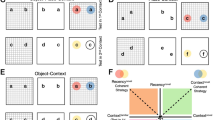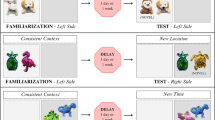Abstract
Rats and mice have a tendency to interact more with a novel object than with a familiar object. This tendency has been used by behavioral pharmacologists and neuroscientists to study learning and memory. A popular protocol for such research is the object-recognition task. Animals are first placed in an apparatus and allowed to explore an object. After a prescribed interval, the animal is returned to the apparatus, which now contains the familiar object and a novel object. Object recognition is distinguished by more time spent interacting with the novel object. Although the exact processes that underlie this 'recognition memory' requires further elucidation, this method has been used to study mutant mice, aging deficits, early developmental influences, nootropic manipulations, teratological drug exposure and novelty seeking.
This is a preview of subscription content, access via your institution
Access options
Subscribe to this journal
Receive 12 print issues and online access
$259.00 per year
only $21.58 per issue
Buy this article
- Purchase on Springer Link
- Instant access to full article PDF
Prices may be subject to local taxes which are calculated during checkout


Similar content being viewed by others
References
Berlyne, D.E. Novelty and curiosity as determinants of exploratory behaviour. Br. J. Psychol. 41, 68–80 (1950).
Fowler, H. Curiosity and Exploratory Behavior (The Macmillan Company, New York, 1965).
Ennaceur, A. & Delacour, J. A new one-trial test for neurobiological studies of memory in rats. 1: Behavioral data. Behav. Brain Res. 31, 47–59 (1988).
Aggleton, J.P. & Pearce, J.M. Neural systems underlying episodic memory: insights from animal research. Phil. Trans. R. Soc. London. B 356, 1467–1482 (2001).
Mumby, D.G. Perspectives on object-recognition memory following hippocampal damage: lessons from studies in rats. Behav. Brain Res. 127, 159–181 (2001).
Besheer, J., Jensen, H.C. & Bevins, R.A. Dopamine antagonism in a novel-object preference and a novel-object place conditioning preparation with rats. Behav. Brain Res. 103, 35–44 (1999).
Ennaceur, A. & Meliani, K. Effects of physostigmine and scopolamine on rats' performances in object recognition and radial-maze tests. Psychopharmacology 109, 321–330 (1992).
Blokland, A., Prickaerts, J., Honig, W. & de Vente, J. State-dependent impairment in object recognition after hippocampal NOS inhibition. NeuroReport 9, 4205–4208 (1998).
Kornecook, T.J., Kippin, T.E. & Pinel, J.P.J. Basal forebrain damage and object-recognition in rats. Behav. Brain Res. 98, 67–76 (1999).
Puma, C., Baudoin, C. & Bizot, J.-C. Effects of intraseptal infusions of N-methyl-D-aspartate receptor ligands on memory in an object recognition task in rats. Neurosci. Lett. 244, 97–100 (1998).
Kim, C.K. et al. Object recognition and spatial learning and memory in rats prenatally exposed to ethanol. Behav. Neurosci. 111, 985–995 (1997).
Scali, C. et al. Tacrine administration enhances extracellular acetylcholine in vivo and restores cognitive impairment in aged rats. Pharmacol. Res. 36, 463–469 (1997).
Besheer, J. & Bevins, R.A. The impact of nicotine withdrawal on novelty reward and related behaviors. Behav. Neurosci. 117, 327–340 (2003).
Anderson, M.J., Karash, D.L., Ashton, K.M. & Riccio, D.C. The effects of a target-stimulus reminder on performance in a novel-object recognition task. Learn. Motiv. 34, 341–353 (2003).
Besheer, J. & Bevins, R.A. The role of environmental familiarization in novel-object preference. Behav. Processes 50, 19–29 (2000).
Wilkinson, J.L., Herrman, L., Palmatier, M.I. & Bevins, R.A. Rats' novel object interaction as a measure of environmental familiarity. Learn. Motiv. 37, 131–148 (2006).
Courts, F.A. Psychological Statistics: An Introduction (The Dorsey Press, Homewood, IL, 1966).
Acknowledgements
We thank Jessica Linkugel for converting 8-mm video of a novel-object test into a digital file for this protocol. R.A.B. was partially supported by United States Public Health Service grant DA018114 and DA017086 while writing this protocol. J.B. was supported by AA016009.
Author information
Authors and Affiliations
Corresponding author
Ethics declarations
Competing interests
The authors declare no competing financial interests.
Supplementary information
Supplementary Video
Object Recognition Test (MOV 13043 kb)
Rights and permissions
About this article
Cite this article
Bevins, R., Besheer, J. Object recognition in rats and mice: a one-trial non-matching-to-sample learning task to study 'recognition memory'. Nat Protoc 1, 1306–1311 (2006). https://doi.org/10.1038/nprot.2006.205
Published:
Issue Date:
DOI: https://doi.org/10.1038/nprot.2006.205
This article is cited by
-
A prefrontal-thalamic circuit encodes social information for social recognition
Nature Communications (2024)
-
An acute bout of resistance exercise increases BDNF in hippocampus and restores the long-term memory of insulin-resistant rats
Experimental Brain Research (2024)
-
Doxycycline-Loaded Calcium Phosphate Nanoparticles with a Pectin Coat Can Ameliorate Lipopolysaccharide-Induced Neuroinflammation Via Enhancing AMPK
Journal of Neuroimmune Pharmacology (2024)
-
Genetic Ablation of Dentate Hilar Somatostatin-Positive GABAergic Interneurons is Sufficient to Induce Cognitive Impairment
Molecular Neurobiology (2024)
-
Ogt-mediated O-GlcNAcylation inhibits astrocytes activation through modulating NF-κB signaling pathway
Journal of Neuroinflammation (2023)
Comments
By submitting a comment you agree to abide by our Terms and Community Guidelines. If you find something abusive or that does not comply with our terms or guidelines please flag it as inappropriate.



